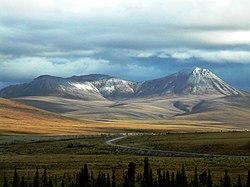The North of Canada is a subarctic and arctic region with sparse population. They are some of the most remote regions on Earth, with vast landscapes and plenty of nature and wildlife to observe. It is also home to the Inuit and several First Nations and is rich in natural resources.
Territories

| Yukon The most accessible of the three territories with the Alaska Highway providing road links to Alaska and British Columbia. There is gold rush history in Dawson City and the mountainous splendour of Kluane National Park. Whitehorse, the capital, provides a good central hub. |
| Northwest Territories |
| Nunavut |
Cities
In this area the term "city" becomes a relative term, especially when measured by population. However, some rather small places (by Southern standards) can have tremendous importance for huge areas as the only thing even approaching a city for hundreds or even thousands of miles. The most important places are:
Other destinations
Much of this area is untouched wilderness or sparsely populated mining and logging country. As such national parks have a natural draw to them. Examples include:
Understand
The North of Canada is a vast area made up of many different environments; ranging from boreal forest, to mountains, to subarctic all the way to high arctic. This is one of the remote places on Earth and even the vast majority of Canadians will never visit the region. However people still live here in one of the most unique places of Canada. Travel here is extremely difficult and expensive. Most will want to visit during the summer when the territories aren't shrouded in near constant darkness, snow and freezing temperatures (to put it lightly). However for those with the funds and motivation, visiting the North of Canada can be an extremely rewarding experience.
Talk
Get in

While it may be possible to drive to Whitehorse and Yellowknife, many other locations (including all of Nunavut) can only be accessed by sea or air. Flights to these areas can often be extremely expensive; see general aviation.
Churchill, Manitoba (YYQ IATA) is reachable by rail and by air from Thompson and Winnipeg; from there, flights depart for Arviat, Baker Lake, Chesterfield Inlet, Coral Harbour, Rankin Inlet, Repulse Bay and Whale Cove.
Get around
See
Do
Eat
Drink
Stay safe
There is no 9-1-1 emergency number in most communities in the Canadian high Arctic, with the possible exception of a small area which includes the Yukon capital of Whitehorse. Use the seven-digit local numbers for the individual services in each community to summon help in an emergency.
The articles cold weather, winter driving and dangerous animals all have advice which will be relevant to many travellers in the arctic.
Go next
